Kohlrabi Kimchi: About this Recipe:
Prep Time
45min + 6hrs soak
Ferment time: 6 days
Total Time
6.5 days
Servings:
900 grams
Equipment: 1 litre clip jar, pickle weight or gü jar, grater, bowl, sharp knife, chopping board, blender or pestle & mortar
Recipe Introduction:
Kohlrabi is such a great ingredient to use in kimchi. I’m using the bulb of the kohlrabi and the leaves, along with some purple kale that I picked up at the farmers market.
The kohlrabi leaves and kale are softer than your traditional cabbage leaves so I keep the ferment time short so the soft leafy material maintains its crispness. This is because too long a ferment and there is the danger of it going mushy.
You should be aware that short ferments do not go through all of the fermentation stages required to achieve the rich diverse range of probiotics found in longer ferments, nor the level of acidity required to preserve the product for several months. This kohlrabi kimchi will however contain plenty of beneficial bacteria but it will need to be eaten within a few weeks.
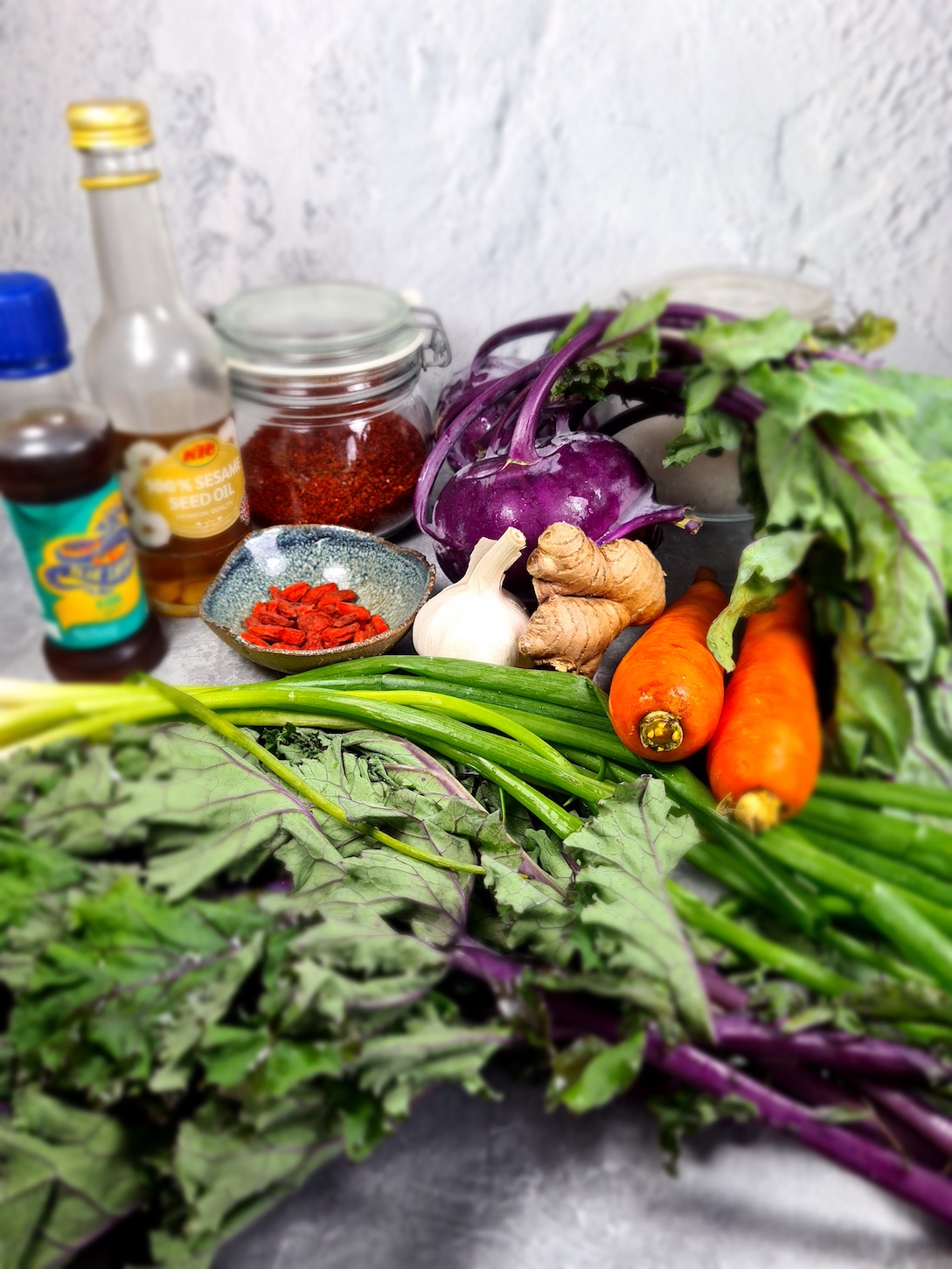
The origins of Kimchi:
Kimchi is the Korean word for fermented vegetables and it was traditionally made at the end of the harvest season and stored in the ground in ceramic pots called Onggi.
Originally kimchi was made with just salt and dried cabbages, however kimchi has developed through the ages with the addition of garlic, fish pastes, spices, radish, other vegetables, and more recently chilli powder.
Common types of kimchi include cabbage kimchi, different types of radish kimchi, water chestnut kimchi, cucumber kimchi, and even fruit kimchi.
Being a member of the cabbage family, kohlrabi lends itself well to kimchi and as such is becoming a modern day kimchi.
The Benefits of Fermenting:
What is fermentation?
Fermentation is the process by which microorganisms, such as yeast and bacteria, convert the carbohydrates in foods, such as starches or sugars, into alcohols or acids.
Why do we ferment?
Preservation:
The alcohols and acids serve as natural preservatives, which was why fermentation was the method utilised before refrigeration to preserve vegetables and crops. This practice was particularly beneficial in the northern and southern hemispheres as it meant that humans could enjoy the nutritional benefit of summer crops during winter.
Flavour:
Fermentation can transform the flavour of food making them tangy, sweet, salty, sour or my favourite, umami. Some popular fermented foods and drinks are cheese, wine, vinegar, beer and spirits.
Health:
Fermented foods and drinks have made a resurgence in recent years due to the beneficial bacteria they contain, namely probiotics (pro=for biotic = life). Our gut flora, the colony of micro-organisms that live in our digestive system is invaluable to our health. It supports our digestive and immune systems, as well as influencing our moods and mental state via the gut:brain connection. The probiotics found in live fermented foods and drinks can help to rebalance the gut flora and promote better health.
Learn more about the fermenting journey to wellness here.
Kohlrabi:
Kohlrabi is a member of the Brassica family which means it is related to cabbage, broccoli, caulflower, kale and brussel sprouts.
It’s texture is similar to that of a water chestnut and the flavour resembles that of the stalk of brocolli or heart of cabbage, only sweeter.
The leaves, stems and bulb are all edible, though the bulb has a tough skin which should be peeled.
It is delicious raw in salads, can be steamed, roasted or sautéed and added to soups and stews. Oh, and of course, it is great for fermenting!
Kohlrabi is very high in vitamin C, as well as being a good source of potassium, fibre, and vitamin B6.
It supports the immune system, promotes gut health and contains powerful plant compounds that are linked to heart health.
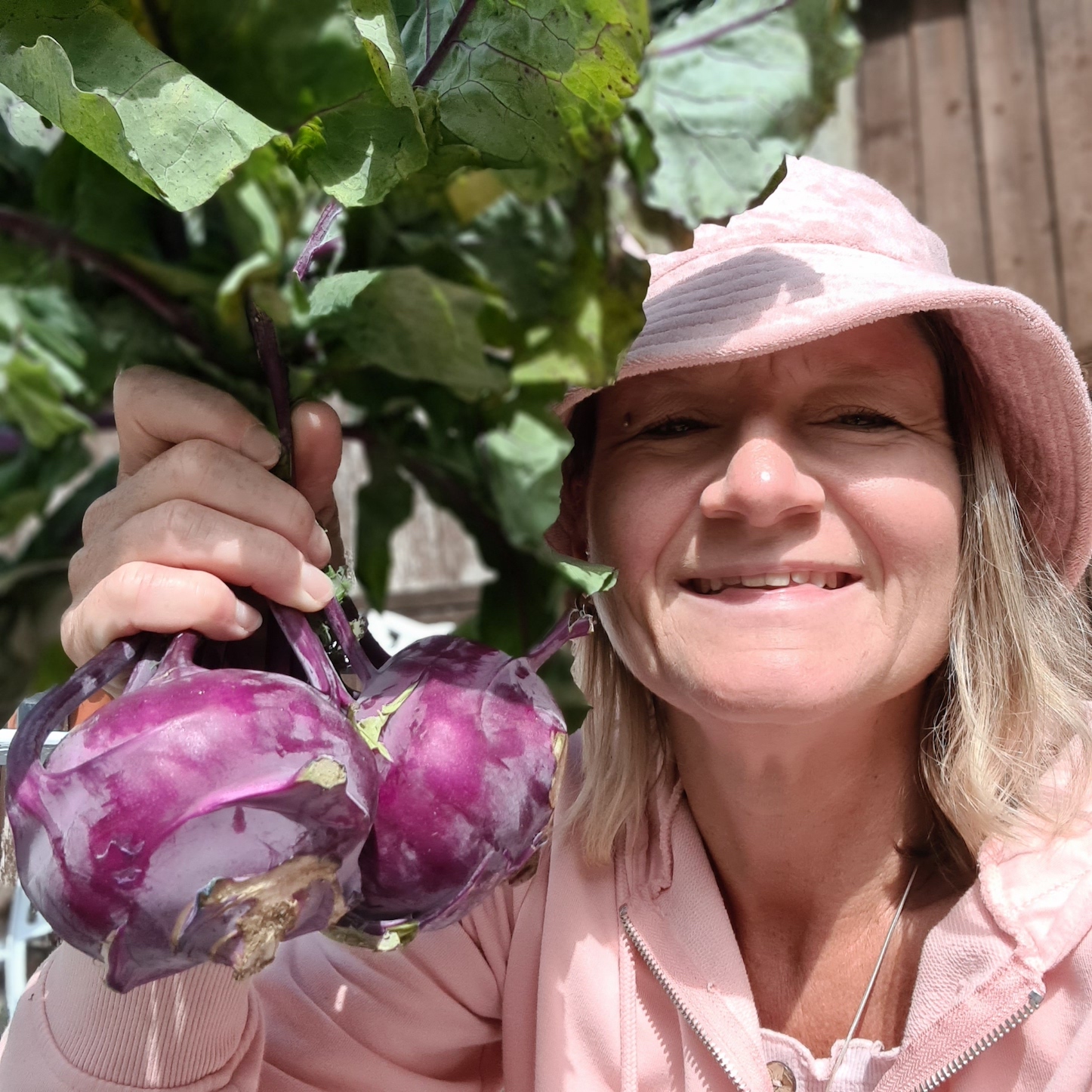
Recipe:
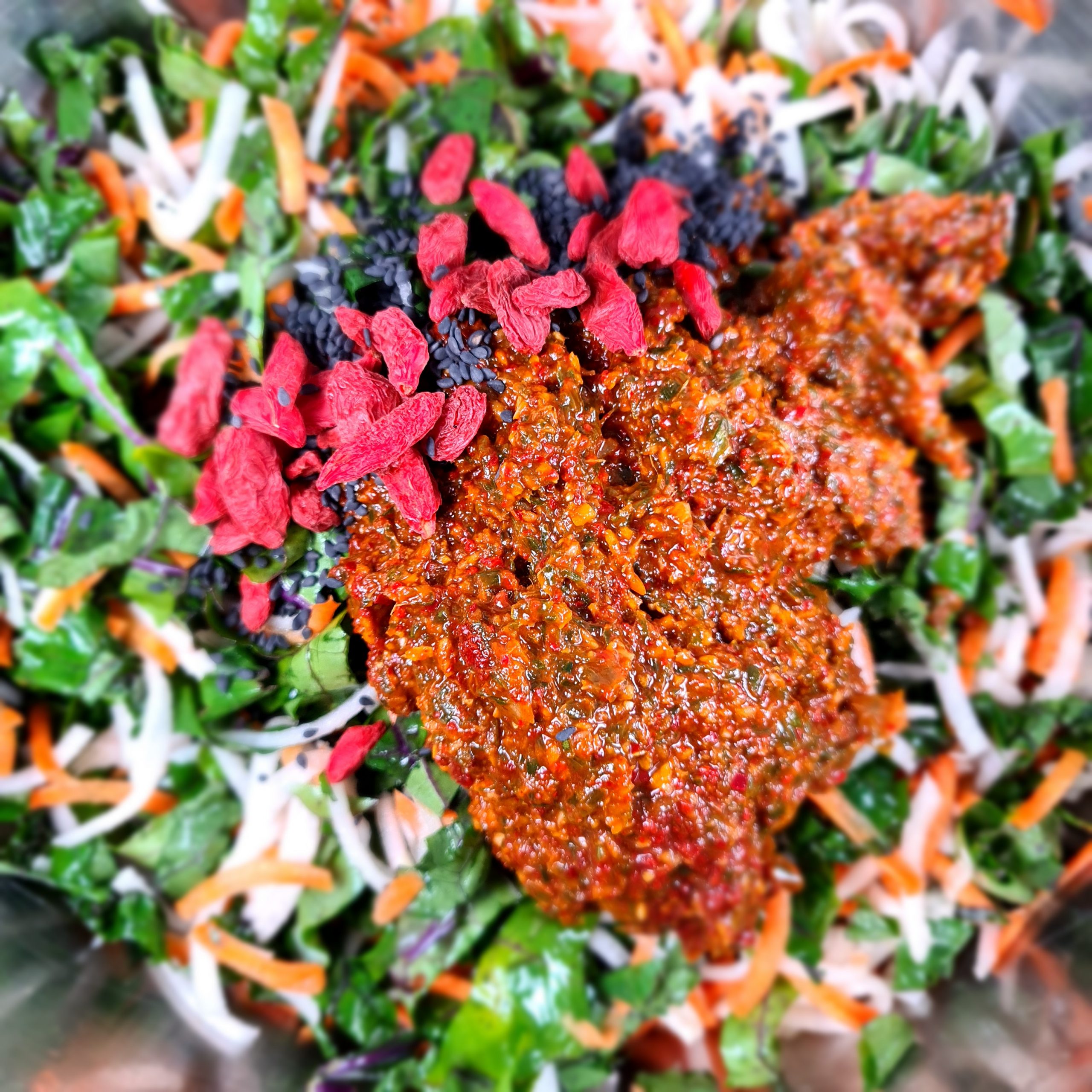
Dairy Free
Gluten Free
Grain Free
Low Carb
Probiotic
Recipe Ingredients:
1 large kohlrabi, grated
Kohlrabi leaves, finely sliced (add extra kale if no leaves)
2 carrots, grated
3 large kale leaves, finely sliced
3 x green onion tops or green onions, finely chopped
1″ nub ginger
4 x garlic cloves
1tbs sesame oil
1tbs fish sauce or vegan alternative (optional)
2tbs gochugaru (Korean red pepper powder) or mild – medium chili powder
1tbs sesame seeds
1tbs goji berries
1.5tbs salt
1.5L water
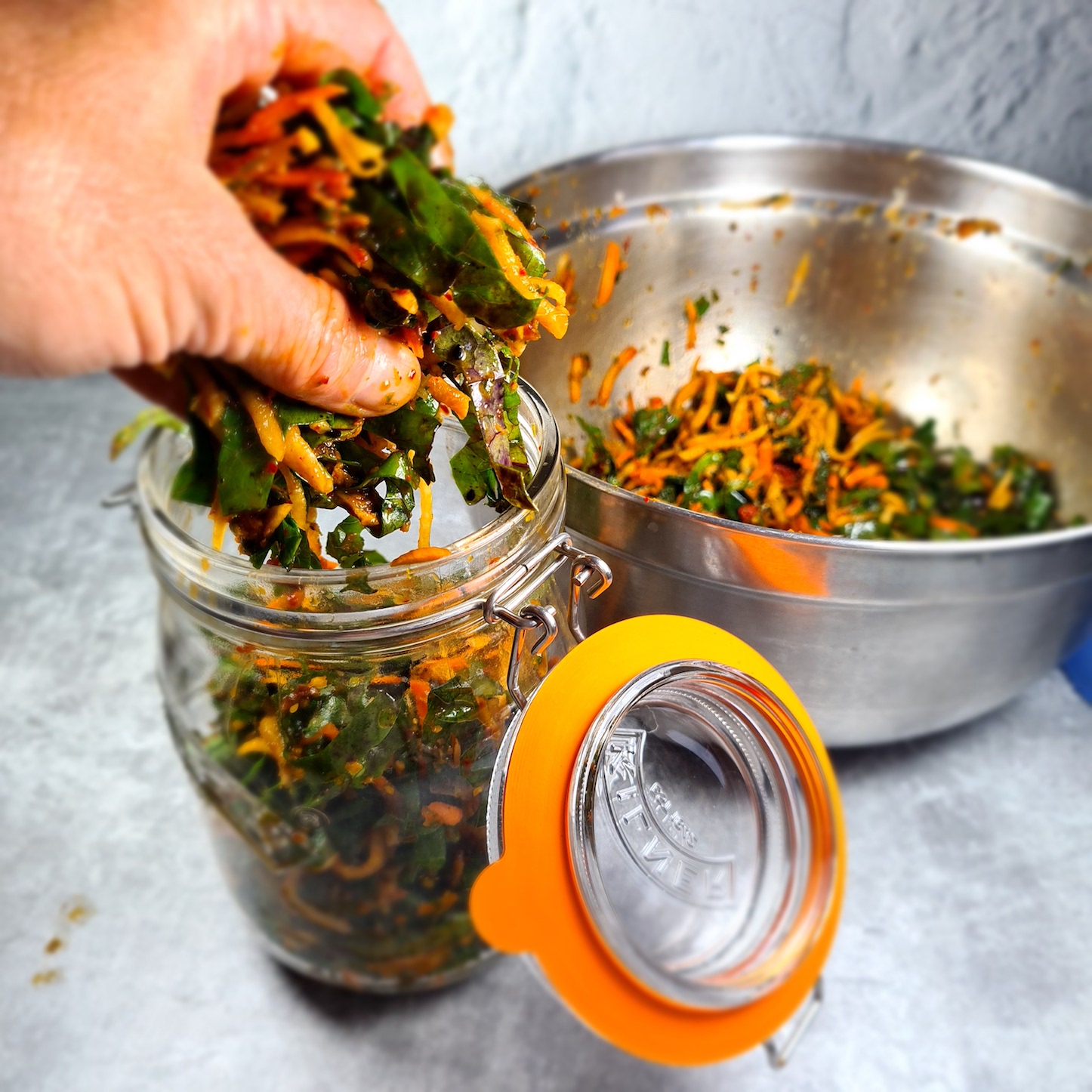
Method:
Step 1:
Disolve the salt in the water.
Step 2:
Place the grated kohlrabi, carrots and finely sliced kale and kohlrabi leaves in a large bowl and cover with salt water brine. Cover and leave to soak for 6 hours.
Step 3:
Place the green onion tops, ginger, garlic, sesame oil, fish sauce and gochugaru into a blender or pestle and mortar and blend / grind to a fine paste. Refrigerate.
Step 4:
After 6 hours drain the vegetables, reserving a little of the liquid.
Step 5:
In a large bowl mix the vegetables, kimchi paste, sesame seeds and goji berries until well combined.
Step 6:
Transfer to a 1 L clip top jar, firmly pressing down the contents as you go to eleminate any air pockets.
Step 7:
Add a little of the reserved liquid to cover and place a pickle weight or Gü jar on top to weigh the contents down.
Step 8:
Leave for 6-7 days then refrigerate and enjoy!
Recipe Tips:
Your ferment should start to bubble after 2 to 4 days. The clip jar allows gas to escape but no air (more importantly oxygen) to enter. Liquid may escape if the jar is full so it is best to place the jar on something to catch it.
This video was taken after 48 hours of fermenting. I like to call it ‘The Kimchi Fizz’.
The process of making kimchi is a lactic acid fermentation, a process that needs to take place in the absence of oxygen. The clip jar is a great vessel to use as it allows the gas to escape but no air to enter. You should fill your jar at least to the neck to reduce the amount of air inside. Air can contain pathogens and they are a risk to your ferment. Keeping your ferment under a level of liquid further protecting the ferment from the risk of pathogens.
I use the traditional Korean gochugaru pepper powder that gives kimchi it’s rich red colour. This is not a spicy pepper powder so if you like your kimchi to have a bit of a bite then you can add some hotter chilli. If you don’t have gochugaru you can use any mild to medium chilli powder.
The goji berry is a nutritional powerhouse, being especially high in iron, vitamin A and C. High intake of antioxidants is linked to reduced levels of inflammation, improved immune function and protection against chronic conditions like cancer, heart disease and diabetes.
Being native to Asia the goji berry is an excellent addition to kimchi.
Serving suggestion: use as a side to pretty much any dish, at any meal. Make a kimchi slaw, blend to a sauce, snack with plantain chips or top a burger for some Asian flair.
Cooking with kimchi: Kimchi fried rice, kimchi dumplings, add to pancake mix or crispy dosas (a fermented pankcake), add to a stir-fry with tempeh or tofu, soups, stews (jjigae), kimchi noodles, even kimchi spaghetti!
Stay In Touch!
Newsletter Sign up!
Follow Me On Social Media!
Did you try this recipe?
I’d love to hear your feedback! Let me know if you have any questions too!

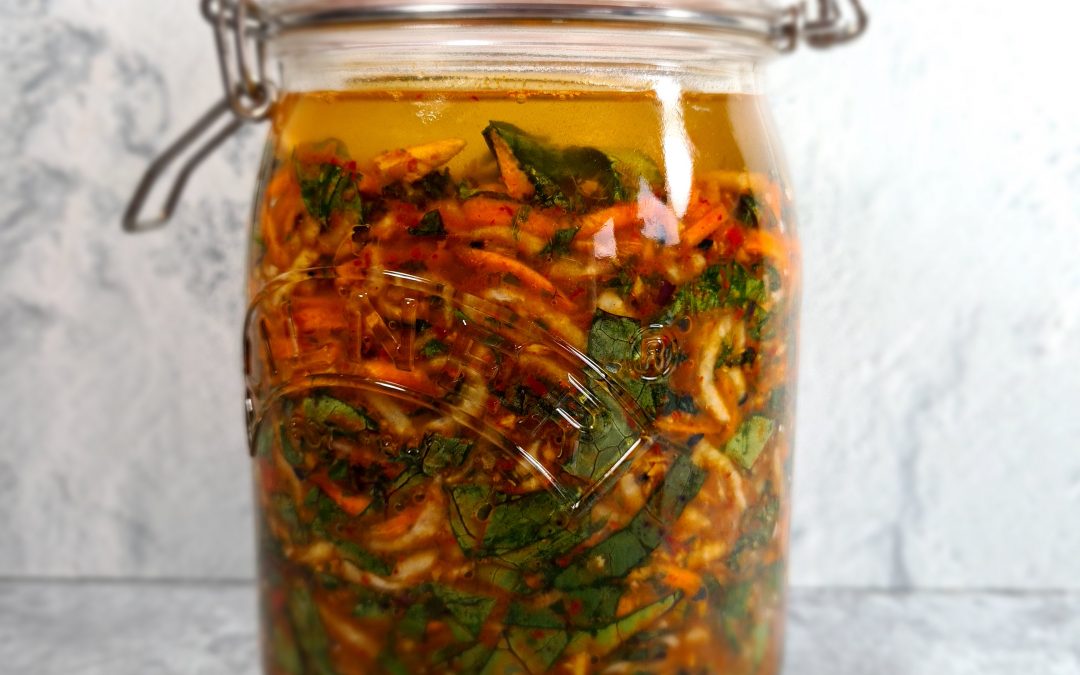
0 Comments